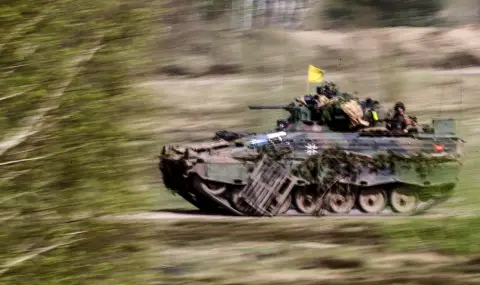In the event of a conflict with Russia, Europe will have to mobilize an additional 300,000 soldiers if it cannot rely on the US. This is the conclusion of an analysis by the Kiel Institute for World Economy.
To effectively counter Russian military power, huge investments in defense will also be needed - 250 billion euros per year, says the analysis, prepared jointly with the Brussels research institute “Brugel".
Defense spending must increase
The authors believe that European countries will have to form an additional 50 brigades with a total of 300,000 soldiers. To this must be added at least 1,400 new battle tanks and 2,000 armored vehicles, which is more than what Germany, France, Italy and the United Kingdom currently have.
In addition, Europe will have to produce 2,000 long-range drones annually. Scientists propose an increase in European defense spending from two percent per year to 3.5-4 percent of GDP. For Germany, which is Europe's largest economy, an increase to 3.5 percent would mean defense spending jumping from 80 to 140 billion euros, ARD explains.
Russia has greatly increased its military capacity
Despite losses in the offensive war against Ukraine, Russia has greatly increased its military capacity, the analysis also says. At the end of 2024, there were about 700,000 Russian soldiers in Ukraine - much more than at the beginning of the invasion in 2022.
In addition, in 2024, around 1,550 new tanks and 5,700 armored vehicles were produced, which represents an increase of 220 and 150 percent respectively compared to 2022. Great progress has also been made in drones and long-range ammunition. According to the authors of the analysis, the production of ammunition for long-range missiles has increased by 435 percent.
“In the next three to ten years, Russia could increase its military power to the point of attacking EU countries,” says economist Guntram Wolf, one of the authors of the analysis, quoted by ARD. According to him, this is a real threat. "And that is why it is in Europe's interest to prevent Russia from winning in Ukraine. That would further intensify Moscow's aggression," he added.
Coordination of national armies is needed
The analysis shows that one of the biggest challenges remains military coordination within Europe. While American units operate as a single command corps, European armies operate on a national basis.
"If each country has to defend itself separately, it will mean enormous costs," Wolff stressed. That is why closer coordination and joint provisioning are important. Half of the annual requirement of at least 250 billion euros could be financed by joint European debts and spent jointly on armaments.
Additional spending of 1.5 percent of GDP
EU countries could finance the other half through their own defense spending. “Although these are large sums, they are within the scope of the EU's economic capacity,” Wolff was quoted as saying by ARD. The additional spending amounts to around 1.5 percent of EU GDP. “This is much less than, for example, the cost of dealing with the crisis during the pandemic”, he specifies.
The authors also see economic advantages in financing additional defense spending with loans: “This could give an impetus to the economic situation in the EU - especially in times of falling external demand due to US tariffs and trade conflicts”, points out Wolf.
Large investments in defense could stimulate national economies. A study by the consulting firm "Ernst & Young" and the bank "Deka" also reaches this conclusion. Investments in armaments will have a particularly positive impact on metalworking, transport and logistics companies, metal trade and research institutes, the authors write. The positive impact on the labor market would be enormous, they also believe.
The 30 NATO countries have already planned to spend 72 billion euros over the next six years. Experts believe that these investments "stimulate both manufacturing and the service sector with the equivalent of 157 billion euros."
According to the study, the planned investments by NATO countries create or guarantee about 190,000 direct jobs in the arms industry alone and 340,000 indirect ones in suppliers. New jobs could also be generated in the consumer sector. Overall, researchers estimate the effect at about 680,000 jobs, the ARD publication also says.
